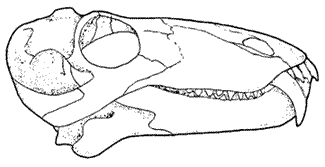 Syodon: S. biarmicum Kutoroga 1838
Syodon: S. biarmicum Kutoroga 1838| Therapsida | ||
| The Vertebrates | Anteosauridae |
| Vertebrates Home | Vertebrate | Vertebrate |
Abbreviated Dendrogram
Synapsida
│
└─Therapsida
├─Biarmosuchia
└─┬─Dinocephalia
│ ├─Stenocybus
│ ├─Estemmenosuchidae
│ ├─Anteosauria
│ │ ├─Brithopodidae
│ │ └─Anteosauridae
│ │ ├─Syodontidae
│ │ │ ├─Notosyodon
│ │ │ └─Syodon
│ │ └─┬─Titanophoneus
│ │ └─Anteosaurinae
│ │ ├─Anteosaurus
│ │ └─Doliosauriscus
│ └─Tapinocephalia
└─┬─Anomodontia
│ ├─Venyukovioidea
│ └─Dicynodontia
└─Theriodontia
├─Gorgonopsia
└─┬─Therocephalia
└─Cynodontia |
Contents
Index |

In the world of the Early Permian, all of the major landmasses except Eurasia were consolidated into a single continent. Eurasia was located to the East of the other landmasses and was probably only in sporadic contact with the rest of the world from a biological point of view. However, during the course of the Permian, the Eurasian landmass (and Mongolia) steamed northwest into the higher latitudes of the Northern hemisphere at a rather fair clip. By the second half of the Permian, the northwesterly drift of Eurasia had brought it into relatively firm and regular contact with Greenland and the Laurentian (North American). Thus Pangaea was formed -- a single continent containing all of the world's major landmasses. At this point, Pangaea looked like the letter 'C'. The Cis-Uralian region was located at the top of the 'C' between about 35° and 50° north latitude.
By contrast, South Africa was almost at the bottom of the world, squeezed between South America and Australia at about 60° South latitude. The two were thus separated by over 10,000 km of land, including the gigantic howling deserts of eastern North America -- perhaps as large and almost certainly hotter than the Sahara today -- and a massive chain of equatorial mountains stretching across Pangaea from Texas to Spain. Yet, somehow, dinocephalians made their way from one to the other. It is not completely clear which way the traffic was going. To judge by species diversity, the carnivorous anteosaurs spread from Russia to the far South; while the herbivorous Tapinocephalia came out of Africa to invade the Cis-Uralian north. In addition there is the unquantifiable possibility that both lineages diverged from some more central locality which has not conveniently left a Permian fossil record. In any event, the Late Permian witnessed the cosmopolitan spread of many therapsid lines which set the stage for the cynodont dominance of the Early Triassic. ATW020523.
Range: Late Permian of Russia & South Africa.
Phylogeny: Anteosauria::: Deuterosaurus + *: Syodontidae + (Titanophoneus + Anteosaurinae).
Characters: ATW020525
Syodontidae: Australocyodon (a South African form!)
Range: Late Permian of Russia & South Africa.
Phylogeny: Anteosauridae: (Titanophoneus + Anteosaurinae) + *: Notosyodon + Syodon.
Characters: ATW020525
Notosyodon: N. gusevi Tchudinov 1968b. Differs from Syodon mainly in larger size and greater pachyostosis and may be a junior synonym. [BS00]
Range: Late Permian of Russia.
Phylogeny: Syodontidae: Syodon + *.
Characters: medium size [BS00]; massive skull [BS00]; orbital and parietal regions very strongly pachyostosed [BS00]; interorbital skull flat & straight, without median ridge [BS00]; orbits large [BS00]; parietal boss high & massive [BS00]; temporal fenestrae large [BS00]; upper portion of occiput strongly slanted posteroventrally [BS00]; occipital condyle very large [BS00].
Comments: Known from a skull, missing the lower jaw and anterior rostrum, as well as 2 teeth and referred jaw fragments.
References: Battail & Surkov (2000) [BS00]. ATW020927.
 Syodon: S. biarmicum Kutoroga 1838
Syodon: S. biarmicum Kutoroga 1838
Range: Late Permian of Russia.
Phylogeny: Syodontidae: Notosyodon + *.
Characters: small body [BS00]; skull moderately high [BS00]; pineal opening and boss large [BS00]; orbits large [BS00]; postorbital hone large and thick, providing external area for origin of part of superficial adductor musculature [O62?]; palatines & pterygoids with teeth [BS00]; canines rounded and curved [BS00]; postcanines small & transversely compressed [BS00]; femora slender with ridges and condyles weakly developed, and with a slight curvature [O62?].
Comments: known from two skulls, one with lower jaw, and various postcrania. Kutoroga's holotype was a single canine. This extraordinary Russian scientist is largely forgotten now. However, he was the first to spot the connection between the early therapsids and the mammals. He seems to have had an anatomical intuition and depth of learning which suggests a comparison with Cuvier. 0521554764WS.pdf.
Image: from [O62].
References: Battail & Surkov (2000) [BS00]; Olson (1962) [O62]. ATW020525.
 Titanophoneus: T. potens Efremov 1938.
Titanophoneus: T. potens Efremov 1938.
Range: Late Permian of Russia (Kamennyi Valley, near Isheevo, Perm region. Early Tatarian)
Phylogeny: Anteosauridae:: Anteosaurinae + *.
Characters: Medium to large-sized predator [BS00]; long snout [BS00]; pineal fossa in boss [BS00]; dorsal & posterior orbital margin thickened [BS00] (also prefrontals?); palatines with teeth [BS00]; 7-8 palatine teeth, recurved; 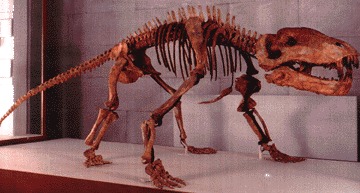 pterygoid flanges with 2 teeth each [BS00]; lower jaw deep; canines large, transversely compressed, with anterior & posterior keels [BS00]; postcanine teeth small [BS00] (implies reliance on mass of jaw for inertial biting, rather than strong jaw muscles); body lightly built [BS00]; pelvis very primitive; femur slender.
pterygoid flanges with 2 teeth each [BS00]; lower jaw deep; canines large, transversely compressed, with anterior & posterior keels [BS00]; postcanine teeth small [BS00] (implies reliance on mass of jaw for inertial biting, rather than strong jaw muscles); body lightly built [BS00]; pelvis very primitive; femur slender.
Comments: Along with Anteosaurus, Titanophoneus was the largest of the anteosaurs, and clearly played the role of a top predator in its terrestrial tetrapod assemblage. The specimen usually illustrated (above) was found articulated and represents a young animal, with a skull about 26 cm in length. An adult skull would be almost one meter in length. The long snout, the long tail and the short limbs are all primitive, typically anteosaur features. It is interesting to compare the above drawing with the mount (see left), apparently of the same animal. In the photograph the back does not have the giraffe-like slope, and the tail appears shorter. MAK 000902.
Links: Titanopheus potens; dinosaurs- titanophoneus potens; Synapsid Classification & Apomorphies; Biology 356; Great Asian Dinosaurs! Unique Creatures from Russia's Vaults - opens December 26, 2001 - ROM Media Release (thumbnails link to huge jpgs); therapsid4a; Titanopheus potens; Synapsid Classification & Apomorphies
References: Battail & Surkov (2000) [BS00]. ATW030920.
Anteosaurinae: These are very specialized, very large anteosaurs. The postcanine teeth are further reduced. Deepening of the postorbital region of the skull (behind the eyes) produced a larger temporal opening, indicating more muscle mass. The boss on the angular (rear of the jaw) has become very prominent, again, another sign of powerful jaw muscles. These huge animals were clearly formidable predators.
In the Anteosaurinae, pachyostosis is taken to extremes. The dorsal (upper) surface of the nasal, frontal, and postfrontals (around and between/above the eyes) is thickened and rugose in the same manner as the tapinocephalids. Nevertheless these animals are two specialized and too late in time to have been the ancestors of the herbivorous tapinocephalids, so it is obvious that these characteristics evolved independently. Boonstra notes that the hip joint and the femur of Anteosaurus is comparable with those of the crocodile and that these animals may have had a crawling habit. In view of the carnivorous dentition, he believes them to have been slinking predators.
Range: Late Permian of Russia & South Africa.
Phylogeny: Anteosauridae:: Titanophoneus + *: Anteosaurus + Doliosauriscus.
Characters: generally very large; peri- and inter-orbital region with strong pachyostosis; larger postorbital skull with larger temporal fenestra; angular with large boss; postcanine teeth further reduced. ATW020525.
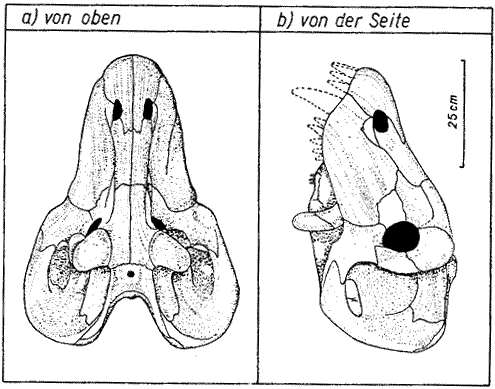 Anteosaurus: A. magnificus Watson 1921. Known from 32 partial or complete skulls, assorted post-cranial elements. Probably the only valid genus and species of Anteosaurus [B69].
Anteosaurus: A. magnificus Watson 1921. Known from 32 partial or complete skulls, assorted post-cranial elements. Probably the only valid genus and species of Anteosaurus [B69].
Range: Late Permian of South Africa (Tapinocephalus Zone - Capitanian epoch).
Phylogeny: Anteosaurinae: Doliosauriscus + *.
Characters: adult skull - 80 cm long; overall length probably 5- 6 m, weight 500- 600 kg; postfrontal forms a boss of variable size overhanging the dorso-posterior border of the orbit [B69].
Comments: On this basis of his 1969 description, Boonstra [B69] synonymised six of the seven genera named from the Tapinocephalus zone: Eccasaurus, Anteosaurus, Titanognathus, Dinosuchus, Micranteosaurus, and Pseudanteosaurus. Of these, he says, Dinosuchus and Titanognathus can safely be considered synonyms of Anteosaurus. Eccasaurus, with a holotype of which the cranial material consists of only few typical anteosaurid incisors, appears to be only determinable as to family. The skull fragment forming the holotype of Pseudanteosaurus can best be considered as an immature specimen of Anteosaurus. Micranteosaurus, the holotype of which contains a small snout, was previously considered a new genus on account of its small size but is better be interpreted as a young specimen of Anteosaurus. And likewise, the large number of species attributed to the genus Anteosaurus can also be considered synonyms.
Boonstra still considers as valid the genus Paranteosaurus, which is defined as a genus of anteosaurids in which the postfrontal is not developed to form a boss. This is probably an example of individual variation and hence another synonym of Anteosaurus.
As with the genera, so the species are also mostly synonyms. The oldest species name, A. magnificus, is thus the only valid one. To quote Boonstra again:
"We have 32 skulls of Anteosaurus, of which 16 are reasonably well preserved and on them ten species have been named. To differentiate between the species the following main characters have been used: the number, size and shape of the teeth, skull size, shape and the nature of the pachyostosis. On re-examination it has become clear that the crowns of the teeth are seldom well preserved; basing the count for the dental formula on the preserved roots is unreliable. As this is affected by age and tooth generation; size of skull is a function of age and also possibly sex; skull shape is greatly affected by post-mortem deformation, and the variability in the pachyostosis, which may be specific in some respects, can just as well be the result of...physiological processes. Specific diagnosis consisting of the enumeration of differences of degree in features such as the above can hardly be considered as sufficient indication of the existence of discrete species.... A. magnificus thus has the following synonyms: abeli, acutirostrus, crassifrons, cruentus, laticeps, levops, lotzi, major, minor, minusculus, parvus, priscus and vorsteri."
The reason for the synonymy he gives as follows: the holotypes of cruentus, levops, minor, minusculus, and parvus are of immature animals; lotzi and priscus are specifically indeterminable; and in the case of abeli, acutirostrus, crassifrons, laticeps, major and vorsteri because the characters used are either due to post-mortem deformation or individual variation in the degree of pachyostosis. Ironically, a lot of these specific and generic synonyms were named by Boonstra himself, who reversed his earlier decisions later on.
Image: from [M85].
Links: Anteosaurus (excellent images); therapsid4b, therapsid4c (notes on way of life); South African Museum - Fossil Reptiles of the South African Karoo fauna); South African Journal of Science abstract on fauna & biozone).
References: Boonstra (1969) [B69]; Müller (1985) [M85]. ATW030807.
Doliosauriscus: D. yanshinovi Kuhn 1961; D. adamanteus Orlov 1958 (distinguished by having shorter snout).
Range: Late Permian of Russia.
Phylogeny: Anteosaurinae: Anteosaurus + *.
large [BS00]; skull high [BS00]; skull roof thickened, with tuberosities [BS00]; orbits small [BS00]; thick postorbital bar [BS00]; palatines & pterygoids with small teeth [BS00]; strong lower jaw with massive symphysis [BS00]; canines rounded [BS00]; palatal depressions house canines & first postcanine teeth [BS00].
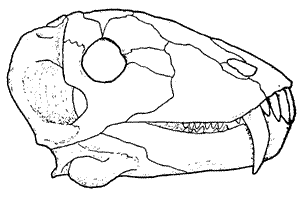
Along with Titanophoneus, this is the largest species of anteosaur from Isheevo. According to Olson (1962), there is an excellent skull (right), with some restoration and some flattening. The skull is high and straight, the orbits and pineal opening not very large. All dorsal (upper) skull bones thickened with tuberosities, the parietals (in the middle rear) greatly so.
Olson (1962) suggests that the crushing may be somewhat less extensive than Orlov's restorations suggest and that the skull was proportionately somewhat lower and broader than that of Titanophoneus. The postorbital bone is very large and forms a strong bar between the orbit and the temporal opening, for the attachment of the jaw musculature. In spite of the large size the skull is typically brithopodid, the basic structure much the same as in Titanophoneus and Syodon
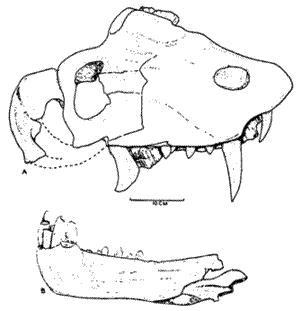 Doliosauriscus adamanteus (Orlov 1958)
Doliosauriscus adamanteus (Orlov 1958)
Locality: Malyi Uran (Churan), Russia
Age: Lower Tatarian Substage, Middle Permian ("Zone II")
Material: known from the skull (right)
A,. Skull in lateral aspect as preserved B Lower jaw and teeth. There is no certainty these come from the same animal. Both from Malyi Uran locality. Skull length 500-550 mm.
This species is based upon a specimen from Malyi Uran (Malouran). Olson 1962) suggests that this specimen is sufficiently different from D. yanshinovi that it might well be considered a different genus, related more closely to Titanophoneus.
References: Battail & Surkov (2000) [BS00]; Olson (1962) [O62]. ATW020525.
checked ATW041118; last modified MAK091114